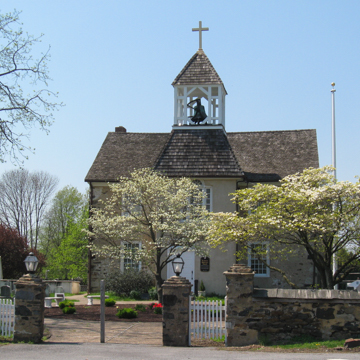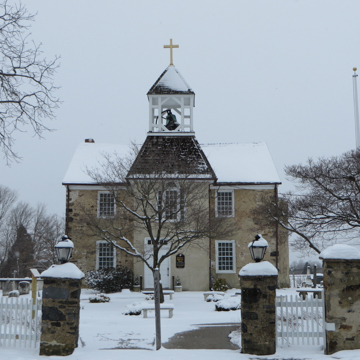Another Anglican congregation founded by the Society for the Propagation of the Gospel, St. James served English and Swedes who had settled at Stanton, forming a serious rival to Immanuel Church at New Castle (NC10). The present stone building with doors on three facades replaced a wooden one of 1717 that burned in 1820. The cozy interior, refurbished in 2003, has a barrel-vaulted ceiling, a gallery on three sides (its posts replaced), and box pews. The curved apse originally held a Palladian window, for which a Gothic stained-glass window was later substituted. The stone tower is original, with modifications: the arched window is now a Palladian one that curves outward—evidently the apse window, moved here—and a belfry has been added above (the mansard roof that it supports has been reshingled without its graceful kick). The old stuccoed walls are rough and mellow. The churchyard is believed to have tombs dating as early as 1726; the carving on one black slate of 1743 is whimsically crude. The stone wall dates to 1817. A century later, the churchyard was noted for its firs and lindens and was a popular picnicking spot. In the early twentieth century, blackbirds were so thick in the trees that a rector used roman candles to scare them off, briefly setting the church on fire.
You are here
St. James Episcopal Church Millcreek Hundred
1820–1823. c. 1895 belfry. Old Capitol Trail and St. James Church Rd., 0.8 miles northwest of Stanton
If SAH Archipedia has been useful to you, please consider supporting it.
SAH Archipedia tells the story of the United States through its buildings, landscapes, and cities. This freely available resource empowers the public with authoritative knowledge that deepens their understanding and appreciation of the built environment. But the Society of Architectural Historians, which created SAH Archipedia with University of Virginia Press, needs your support to maintain the high-caliber research, writing, photography, cartography, editing, design, and programming that make SAH Archipedia a trusted online resource available to all who value the history of place, heritage tourism, and learning.
























